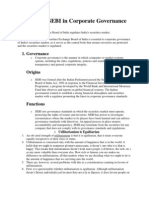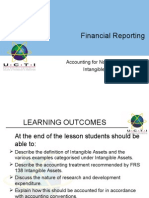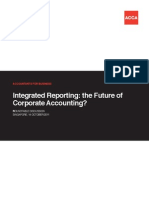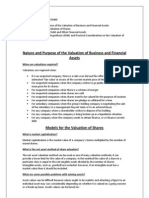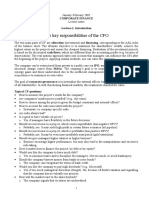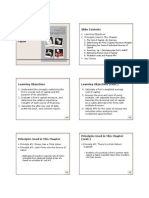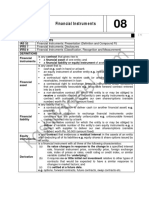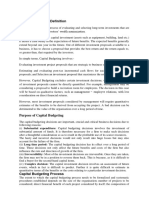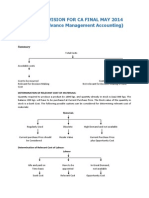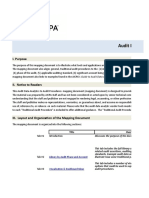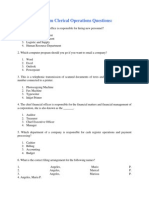CH 2 Capital Budgeting Final
CH 2 Capital Budgeting Final
Uploaded by
SureshArigelaCopyright:
Available Formats
CH 2 Capital Budgeting Final
CH 2 Capital Budgeting Final
Uploaded by
SureshArigelaOriginal Description:
Original Title
Copyright
Available Formats
Share this document
Did you find this document useful?
Is this content inappropriate?
Copyright:
Available Formats
CH 2 Capital Budgeting Final
CH 2 Capital Budgeting Final
Uploaded by
SureshArigelaCopyright:
Available Formats
Dubeys The Dreams.
CAPITAL BUDGETING DECISIONS
Concept:
Where should you put your money? put it where your mouth is, said the wag.
In business you should put your money in those assets and those projects that maximise wealth.
Capital budgeting function involves organisations decision to invest its resources in long term
assets like land, building, equipments, vehicles etc. So capital budgeting is budgeting for capital
expenditure. Forgetting taxation for a moment, capital expenditure means making a large outlay
of money today in anticipation of benefits (cash inflows) which would flow across the life of the
investment
The basic feature of capital budgeting decision is:
1) Current funds are exchanged for future benefits
(Large outlay)
2) There is an investment in long term activities; and
(Irreversible)
3) The future benefits will occur to the firm over series of years. ( future impact)
Need for CAPITAL INVESTMENT
1)
2)
3)
4)
5)
6)
7)
8)
9)
Wear and tear of old equipments.
Obsolescence
Variation in product demand necessitating change in volume of production.
Product improvement requiring capital addition.
Learning curve effect.
Expansion.
Change of plant site.
Diversification
Productivity improvement
IMPORTANCE OF CAPITAL BUDGETING
1)
2)
3)
4)
5)
Long-term implication.
Involvement of large amount of funds
Irreversible decisions
Risk and uncertainty
Difficult to make
Factors influencing investment decision
1)
2)
3)
4)
5)
6)
7)
Management outlook.
Competitors strategy.
Opportunities
Market forecast
Fiscal incentives
Cash flow budget
Non economic factors
Compiled by- C.A. Hardik Patel Email: ca.hkpatel@yahoo.com
Dubeys The Dreams.
TYPES OF CAPITAL INVESTMENT DECISIONS
(A)On the basis of firms existence: The capital budgeting decisions are taken by both newly
incorporated firms as well as by existing firms. The new firms may be required to take decision in respect of
selection of a plant to be installed. The existing firm may be required to take decisions to meet the
requirement of new environment or to face the challenges of competition. These decisions may be
classified as follows:
(i) Replacement and Modernisation decisions: The replacement and modernisation decisions aim at to
improve operating efficiency and to reduce cost. Generally all types of plant and machinery require
replacement either because of the economic life of the plant or machinery is over or because it has become
technologically outdated. The former decision is known as replacement decisions and later one is known as
modernisation decisions. Both replacement and modernisation decisions are called cost reduction
decisions.
(ii) Expansion decisions: Existing successful firms may experience growth in demand of their product line.
If such firms experience shortage or delay in the delivery of their productsdue to inadequate production
facilities, they may consider proposal to add capacity to existing product line.
(iii) Diversification decisions: These decisions require evaluation of proposals to diversify into new
product lines, new markets etc. for reducing the risk of failure by dealing in different products or by
operating in several markets.
(B)On the basis of decision situation:
(i) Mutually exclusive decisions: The decisions are said to be mutually exclusive if two or more alternative
proposals are such that the acceptance of one proposal will exclude the acceptance of the other alternative
proposals. For instance, a firm may be considering proposal to install a semi-automatic or highly automatic
machine. If the firm install a semi-automatic machine it exclude the acceptance of proposal to install highly
automatic machine.
(ii) Accept-reject decisions: The accept-reject decisions occur when proposals are independent and do
not compete with each other. The firm may accept or reject a proposal on the basis of a minimum return on
the required investment. All those proposals which give a higher return than certain desired rate of return
are accepted and the rest are rejected.
(iii) Contingent decisions: The contingent decisions are dependable proposals. The investment in one
proposal requires investment in one or more other proposals. For example if a company accepts a proposal
to set up a factory in remote area it may have to invest in infrastructure also e.g. building of roads, houses
for employees etc.
Procedure of Capital Budgeting
1) Identification of potential opportunities
2) Establishing the criteria
3) Screening and co-ordination
4) Evaluating investment proposals
5) Budgeting capital expenditure
6) Controlling project in process
7) Follow up and performance report
Compiled by- C.A. Hardik Patel Email: ca.hkpatel@yahoo.com
Dubeys The Dreams.
The principle of time value of money
A rupee received today is greater than a rupee received tomorrow because money has time
value of money. I.e. Earlier is better. Because of.....
1) Opportunity Cost: money received today can be reinvested to earn additional
Interest and return.
2) Inflation: Inflation decrease purchasing power of money, as price of goods and
Services , purchasing power .
3) Risk: future is always uncertain and unpredictable; therefore money received now
is certain whereas money received in future is less certain.
PROJECT EVALUATION TECHNIQUES
CAPITAL BUDGETING TECHNIQUES
TRADITIONAL OR NON DISCOUNTING
TIME ADJUSTED OR DISCOUNTED CASHFLOW
Payback period
method
Average Accounting
Rate of return Method
Net Present value Method
Profitability index Method or
Benefit cost Ratio
Internal Rate of Return method
(A) Non Discounting cash flow method
1) The payback period method:
This technique estimates the time required by the project to recover the firms initial outlay, through
cash inflows.
- The payback period for each investment proposal is compared with the maximum period
acceptable to management and
- Proposals are then selected in order of those having minimum payout period.
Payback period: cost of project or initial investment
Annual cash inflow
Imp points: Cash inflow for project should be estimated on an after tax basis. (i.e annual profit
after tax but before depreciation).
Illustration 1
Suppose a project costs Rs. 20,00,000 and yields annually a profit of Rs. 3,00,000 after depreciation @
12% (straight line method) but before tax 50%. The first step would be to calculate the cash inflow from
this project. The cash inflow is Rs. 4,00,000 calculated as follows :
Rs.
Profit before tax
3,00,000
Less : Tax @ 50%
1,50,000
Compiled by- C.A. Hardik Patel Email: ca.hkpatel@yahoo.com
Dubeys The Dreams.
Profit after tax
Add : Depreciation written off
Total cash inflow
1,50,000
2,50,000
4,00,000
While calculating cash inflow, depreciation is added back to profit after tax since it does not cash
outflow. The cash generated from a project therefore is equal to profit after tax plus depreciation.
Payback period = Rs.2000000 .Rs= 5 Years
Rs. 400000
Some Accountants calculate payback period after discounting the cash flows by a predetermined rate and the payback
period so calculated is called, Discounted payback period
Sometimes there are projects where the cash inflows are not uniform. In such a situation
cumulative cash inflows will be calculated.
Illustration 2
If the project needs an initial investment of rs.25 L and the annual cash inflow for five years are
Rs. 6 L, Rs 9 L, Rs 7 L, Rs 6 L, and Rs 4 L respectively. The payback period will be calculated as
follows:
Year
Cash Inflow
Cummulative cash inflow
1
6L
6L
2
9L
15 L
3
7L
22 L
4
6L
28 L
5
4L
32 L
It is evident from the above table that in 3 years Rs. 22 L has been recovered and Rs. 3 L is left of
initial investment of Rs. 25 L. It indicates that payback period is between 3 to 4 years calculated as
follows:
Payback period: 3 years + 3 L
=3.5 years
6L
Decision rule: Accept the project if payback period calculated for it is less than the maximum set
by the management, reject the project if it is otherwise.
Payback period shows breakeven point where cash inflow are equal to cash outflows.
Advantages:
A major advantage of the payback period technique is that it is easy to compute and to understand
as it provides a quick estimate of the time needed for the organization to recoup the cash invested.
The length of the payback period can also serve as an estimate of a projects risk; the longer the
payback period, the riskier the project as long-term predictions are less reliable. The payback
period technique focuses on quick payoffs. In some industries with high obsolescence risk or in
situations where an organization is short on cash, short payback periods often become the
determining factor for investments.
Limitations:
The major limitation of the payback period technique is that it ignores the time value of money. As
long as the payback periods for two projects are the same, the payback period technique
considers them equal as investments, even if one project generates most of its net cash inflows in
the early years of the project while the other project generates most of its net cash inflows in the
latter years of the payback period. A second limitation of this technique is its failure to consider an
Compiled by- C.A. Hardik Patel Email: ca.hkpatel@yahoo.com
Dubeys The Dreams.
investments total profitability; it only considers cash flows from the initiation of the project until its
payback period and ignores cash flows after the payback period. Lastly, use of the payback period
technique may cause organizations to place too much emphasis on short payback periods thereby
ignoring the need to invest in long-term projects that would enhance its competitive position.
It may be said that payback period is defined as the measure of project liquidity and capital
recovery rather than its profitability
2) Average Accounting (Book) Rate of Return (ARR): The accounting rate of return of an
investment measures the average annual net income of the project (incremental income) as a
percentage of the investment.
ARR in original investment:
= Average Net earnings after depreciation and taxes
Original investment (average investment)
The numerator is the average annual net income generated by the project over its useful life. The
denominator can be either the initial investment or the average investment over the useful life of
the project. Some organizations prefer the initial investment because it is objectively determined
and is not influenced by either the choice of the depreciation method or the estimation of the
salvage value. Either of these amounts is used in practice but it is important that the same method
be used for all investments under consideration.
Decision Rule: Accept the proposal if ARR > minimum rate of return (cut off rate)
Reject the proposal if ARR < Minimum rate of return (cut off rate)
Advantages:
The accounting rate of return technique uses readily available data that is routinely generated for
financial reports and does not require any special procedures to generate data. This method may
also mirror the method used to evaluate performance on the operating results of an investment
and management performance. Using the same procedure in both decision-making and
performance evaluation ensures consistency. Lastly, the calculation of the accounting rate of
return method considers all net incomes over the entire life of the project and provides a measure
of the investments profitability.
Limitations:
The accounting rate of return technique, like the payback period technique, ignores the time value
of money and considers the value of all cash flows to be equal. Additionally, the technique uses
accounting numbers that are dependent on the organizations choice of accounting procedures,
and different accounting procedures, e.g., depreciation methods, can lead to substantially different
amounts for an investments net income and book values. The method uses net income rather
than cash flows; while net income is a useful measure of profitability, the net cash flow is a better
measure of an investments performance. Furthermore, inclusion of only the book value of the
invested asset ignores the fact that a project can require commitments of working capital and other
outlays that are not included in the book value of the project.
Compiled by- C.A. Hardik Patel Email: ca.hkpatel@yahoo.com
Dubeys The Dreams.
Illustration 3
Suppose a project requiring an investment of Rs. 10,00,000 yields profit after tax and
depreciation as follows:
Years
Profit after tax and depreciation
Rs.
1.
50,000
2.
75,000
3.
1,25,000
4.
1,30,000
5.
80,000
Total
4,60,000
Suppose further that at the end of 5 years, the plant and machinery of the project can be
sold for Rs. 80,000. In this case the rate of return can be calculated as follows.
Total profit x 100
Net investment in project x no of years of profit
460000 x 100
920000 x 5 years
=10%
This rate is compared with the rate expected on other projects, had the same funds been invested
alternatively in those projects. Sometimes, the management compares this rate with the minimum
rate (called-cut off rate) they may have in mind. For example, management may decide that they
will not undertake any project which has an average annual yield after tax less than 15%. Any
capital expenditure proposal which has an average annual yield of less than 15% will be
automatically rejected.
(B)Discounted Cash Flow Methods
(1) Net Present Value Method:
The net present value technique is a discounted cash flow method that considers the time value of
money in evaluating capital investments. An investment has cash flows throughout its life, and it is
assumed that a rupee of cash flow in the early years of an investment is worth more than a rupee
of cash flow in a later year. The net present value method uses a specified discount rate to bring
all subsequent net cash inflows after the initial investment to their present values (the time of the
initial investment or year 0).
The discount rate or desired rate of return on an investment is the rate of return the firm would
have earned by investing the same funds in the best available alternative investment that has the
same risk.
Net present value = Present value of net cash Inflow - Total net initial investment
The steps to calculating net present value are (1) Determine the net cash inflow in each year of
the investment, (2) select the desired rate of return, (3) Find the discount factor for each year
based on the desired rate of return selected, (4) Determine the present values of the netcash flows
by multiplying the cash flows by the discount factors, (5) Total the amounts for all years in the life
of the project, and (6) Subtract the total net initial investment.
Compiled by- C.A. Hardik Patel Email: ca.hkpatel@yahoo.com
Dubeys The Dreams.
Illustration 4
Compute the net present value for a project with a net investment of Rs. 1, 00,000 and the
following cash flows if the companys cost of capital is 10%? Net cash flows for year one is
Rs. 55,000; for year two is Rs. 80,000 and for year three is Rs. 15,000.
[PVIF @ 10% for three years are 0.909, 0.826 and 0.751]
Solution Year
Net Cash
PVIF @
Discounted
Flows
10%
Cash
Flows
1
55,000
0.909
49,995
2
80,000
0.826
66,080
3
15,000
0.751
11,265
1,27,340
Total Discounted Cash Flows 1,27,340
Less: Net Investment 1,00,000
Net Present Value 27,340
Recommendation: Since the net present value of the project is positive, the company should
accept the project.
Decision Rule: If NPV > Zero : Accept the project
NPV < Zero: Reject the project
NPV = Zero: Firm is indifferent to accept or reject the project.
Advantages
(i) NPV method takes into account the time value of money.
(ii) The whole stream of cash flows is considered.
(iii) The net present value can be seen as the addition to the wealth of share holders. The criterion
of NPV is thus in conformity with basic financial objectives.
(iv) The NPV uses the discounted cash flows i.e., expresses cash flows in terms of current rupees.
The NPVs of different projects therefore can be compared. It implies that each project can be
evaluated independent of others on its own merit.
Limitations
(i) It involves difficult calculations.
(ii) The application of this method necessitates forecasting cash flows and the discount rate. Thus
accuracy of NPV depends on accurate estimation of these two factors which may be quite difficult
in practice.
(iii) The ranking of projects depends on the discount rate. Let us consider two projects involving an
initial outlay of Rs. 25 lakhs each with following inflow :
(Rs in lakhs) 1st year
2nd year
Project A
50.0
12.5
Project B
12.5
50.0
At discounted rate of 5% and 10% the NPV of Projects and their rankings at 5% and 10% are as
follows:
Compiled by- C.A. Hardik Patel Email: ca.hkpatel@yahoo.com
Dubeys The Dreams.
NPV@5% Rank
Project A
Project B
33.94
32.25
I
II
NPV@10% Rank
30.78
27.66
I
II
The project ranking is same when the discount rate is changed from 5% to 10%. However, the
impact of the discounting becomes more severe for the later cash flows. Naturally, higher the
discount rate, higher would be the impact. In the case of project B the larger cash flows come later
in the project life, thus decreasing the present value to a larger extent.
(iv) The decision under NPV method is based on absolute measure. It ignores the difference in
initial outflows, size of different proposals etc. while evaluating mutually exclusive projects.
(2) Profitability index (PI) or desirability Factor
PI is defined as the rate of present value of the future cash benefits at the required rate of return to
the initial cash outflow of the investment.
PI:
Sum of discounted cash inflows
Initial cash outlay/Total discounted cash outflow (as the case may be)
Illustration 5
we have three projects involving discounted cash outflow of Rs.5,50,000, Rs75,000 and
Rs.1,00,20,000 respectively. Suppose further that the sum of discounted cash inflows for these
projects are Rs. 6,50,000, Rs. 95,000 and Rs 1,00,30,000 respectively. Calculate the desirability
factors for the three projects.
Solution
The desirability factors for the three projects would be as follows:
1. Rs.650000
2. Rs.95000
3. Rs.10,030,000
Rs.550000. = 1.18
Rs. 75000 =1.27
Rs.10,020,000 =1.001
It would be seen that in absolute terms project 3 gives the highest cash inflows yet its desirability
factor is low. This is because the outflow is also very high. The Desirability/ Profitability Index
factor helps us in ranking various projects.
Advantages
The method also uses the concept of time value of money and is a better project evaluation
technique than NPV.
Limitations
Profitability index fails as a guide in resolving capital rationing where projects are indivisible. Once
a single large project with high NPV is selected, possibility of accepting several small projects
which together may have higher NPV than the single project is excluded. Also situations may arise
where a project with a lower profitability index selected may generate cash flows in such a way
that another project can be taken up one or two years later, the total NPV in such case being more
than the one with a project with highest Profitability Index.
Compiled by- C.A. Hardik Patel Email: ca.hkpatel@yahoo.com
Dubeys The Dreams.
The Profitability Index approach thus cannot be used indiscriminately but all other type of
alternatives of projects will have to be worked out.
CAPITAL RATIONING
(2010 -Jun, 2007-Jun, 2000-Dec)
Generally, firms fix up maximum amount that can be invested in capital projects, during a given
period of time, say a year. The firm then attempts to select a combination of investment proposals
that will be within the specific limits providing maximum profitability and rank them in descending
order according to their rate of return; such a situation is of capital rationing.
A firm should accept all investment projects with positive NPV, with an objective to maximise the
wealth of shareholders. However, there may be resource constraints due to which a firm may have
to select from among various projects. Thus there may arise a situation of capital rationing where
there may be internal or external constraints on procurement of necessary funds to invest in all
investment proposals with positive NPVs.
Capital rationing may also be introduced by following the concept of Responsibility Accounting,
whereby management may introduce capital rationing by authorising a particular department to
make investment only up to a specified limit, beyond which the investment decisions are to be
taken by higher-ups.
The selection of project under capital rationing involves two steps:
(i) To identify the projects which can be accepted by using the technique of evaluation.
(ii) To select the combination of projects.
In capital rationing it may also be more desirable to accept several small investment proposals
than a few large investment proposals so that there may be full utilisation of budgeted amount.
Illustration 6
Alpha Limited is considering five capital projects for the years 2010,2011,2012 and 2013. The
company is financed by equity entirely and its cost of capital is 12%. The expected cash flows of
the projects are as follows :
Year and
2010
2011
2012
2013
Cashflow
(Rs. 000)
Project
A
(70)
35
35
20
B
(40)
(30)
45
55
C
(50)
(60)
70
80
D
(90)
55
65
E
(60)
20
40
50
Note : Figures in brackets represent cash outflows
All projects are divisible i.e. size of investment can be reduced, if necessary in relation to
availability of funds. None of the projects can be delayed or undertaken more than once.
Calculate which project Alpha Limited should undertake if the capital available for investment is
limited to Rs. 1,10,000 in year 2010 and with no limitation in subsequent years. For your analysis,
use the following present value factors:.
Year
2000
2001
2002
2003
Discountig
1.00
0.89
0.80
0.71
factor
Solution: project
Rank
E
1
B
2
C A For project D no limitation
3 4
Compiled by- C.A. Hardik Patel Email: ca.hkpatel@yahoo.com
Dubeys The Dreams.
3) INTERNAL RATE OF RETURN (IRR)
The IRR refers to the rate which equates the present value of cash inflows and present value of
cash outflows. In other words, it is the rate at which NPV of investment is Zero. If NPV is positive,
a higher discount rate may be used to bring it down to equalise the discount cash inflows and vice
versa. That is why IRR is defined as the break even financing rate for the project.
IRR= lower rate + PVCIF at lower rate PVCOF
x Difference in Rate
PVCIF at lower rate PVCIF at higher Rate
Decision Rule: if IRR > Cost of capital (cut off rate) = Accept
IRR Cost of capital (cut off rate) = Reject
Illustration 7
Calculate the internal rate of return of an investment of Rs. 1, 36,000 which yields the following cash
inflows:
Year
Cash Inflows (in Rs.)
1
30,000
2
40,000
3
60,000
4
30,000
5
20,000
Answer: IRR : 10.7%
Advantages:
(i) This method makes use of the concept of time value of money.
(ii) All the cash flows in the project are considered.
(iii) IRR is easier to use as instantaneous understanding of desirability can be determined by
comparing it with the cost of capital
(iv) IRR technique helps in achieving the objective of maximisation of shareholders wealth.
Limitations
(i) The calculation process is tedious if there are more than one cash outflows interspersed
between the cash inflows, there can be multiple IRRs, the interpretation of which is difficult.
(ii) The IRR approach creates a peculiar situation if we compare two projects with different
inflow/outflow patterns.
(iii) It is assumed that under this method all the future cash inflows of a proposal are reinvested at
a rate equal to the IRR. It is ridiculous to imagine that the same firm has a ability to reinvest the
cash flows at a rate equal to IRR.
(iv) If mutually exclusive projects are considered as investment options which have considerably
different cash outlays. A project with a larger fund commitment but lower IRR contributes more in
terms of absolute NPV and increases the shareholders wealth. In such situation decisions based
only on IRR criterion may not be correct.
***Modified Internal Rate of Return (MIRR)
there are several limitations attached with the concept of the conventional Internal Rate of Return.
The MIRR addresses some of these deficiencies e.g, it eliminates multiple IRR rates; it addresses
the reinvestment rate issue and produces results which are consistent with the Net Present Value
method.
Under this method , all cash flows , apart from the initial investment , are brought to the terminal
value using an appropriate discount rate(usually the Cost of Capital). This results in a single
Compiled by- C.A. Hardik Patel Email: ca.hkpatel@yahoo.com
10
Dubeys The Dreams.
stream of cash inflow in the terminal year. The MIRR is obtained by assuming a single outflow in
the zeroth year and the terminal cash in flow as mentioned above. The discount rate which
equates the present value of the terminal cash in flow to the zeroth year outflow is called the
MIRR.
Illustration 8
Using details given in illustration 7, calculate MIRR considering a 8% Cost of Capital .
Ans: MIRR of the investment based on a single cash inflow of Rs 2,13,587 and a zeroth year cash
out flow of Rs 1,36,000 is 9.4% (approximately)
Illustration 9
CXC Company is preparing the capital budget for the next fiscal year and has identified the
following capital investment projects:
Project A: Redesign and modification of an existing product that is current scheduled to be
terminated. The enhanced model would be sold for six more years.
Project B: Expansion of a product that has been produced on an experimental basis for the past
year. The expected life of the product line is eight years.
Project C: Reorganization of the plants distribution centre, including the installation of
computerized equipment for tracking inventory.
Project D: Addition of a new product. In addition to new manufacturing equipment, a significant
amount of introductory advertising would be required. If this project is implemented, Project A
would not be feasible due to limited capacity.
Project E: Automation of the Packaging Department that would result in cost savings over the next
six years.
Project F: Construction of a building wing to accommodate offices presently located in an area that
could be used for manufacturing. This change would not add capacity for new lines but would
alleviate crowded conditions that currently exist, making it possible to improve the productivity of
two existing product lines that have been unable to meet market demand.
The cost of capital for CXC Company is 12%, and it is assumed that any funds not invested in
capital projects and any funds released at the end of a project can be invested at this rate. As a
benchmark for the accounting (book) rate of return, CXC has traditionally used 10%. Further
information about the projects is shown below.
Project A
Project B
Project C
Project D
Project E
Project F
Capital Investment 106,000
200,000
140,000
160,000
144,000
130,000
NPV@12%
69,683
23,773
(10,228)
74,374
6,027
69,513
IRR
35%
15%
9%
27%
14%
26%
Payback Period
2.2 years
4.5 years
3.9 years
4.3 years
2.9 years
3.3 years
ARR
18%
9%
6%
21%
12%
18%
If CXC Company has no budget restrictions for capital expenditures and wishes to maximize
stakeholder value, the company would choose, based on the given information, to proceed with
Projects A or D (mutually exclusive projects), B, E, and F. All of these projects have a positive net
present value and an internal rate of return that is greater that the hurdle rate or cost of capital.
Consequently, any one of these projects will enhance stakeholder value. Project C is omitted
because it has a negative net present value and the internal rate of return is below the 12% cost of
capital.
Compiled by- C.A. Hardik Patel Email: ca.hkpatel@yahoo.com
11
Dubeys The Dreams.
With regard to the mutually exclusive projects, the selection of Project A or Project D is dependent
on the valuation technique used for selection. If net present value is the only technique used, CXC
Company would select Projects B, D, E, and F with a combined net present value of 173,687, the
maximum total available. If either the payback method or theinternal rate of return is used for
selection, Projects A, B, E, and F would be chosen as Project A has a considerably shorter
payback period than Project D, and Project A also has a higher internal rate of return that Project
D. The accounting rate of return for these two projects is quite similar and does not provide much
additional information to inform the companys decision. The deciding factor for CXC Company
between Projects A and D could very well be the payback period and the size of the initial
investment; with Project A, the company would be putting fewer funds at risk for a shorter period of
time.
If CXC Company were to use the accounting rate of return as the sole measurement criteria for
selecting projects, Project B would not be selected. It is clear from the other measures that Project
B will increase stakeholder value and should be implemented if CXC has no budget restrictions;
this clearly illustrates the necessity that multiple measures be used when selecting capital
investment projects.
Rather than an unrestricted budget, let us assume that the CXC capital budget is limited to
4,50,000. In cases where there are budget limitations (referred to as capital rationing), the use of
the net present value technique is generally recommended as the highest total net present value
of the group of projects that fits within the budget limitation will provide the greatest increase in
stakeholder value. The combination of Projects A, B, and F will yield the highest net present value
to CXC Company for an investment of 436,000.
Compiled by- C.A. Hardik Patel Email: ca.hkpatel@yahoo.com
12
Dubeys The Dreams.
RISK ANALYSIS IN CAPITAL BUDGETING DECISION:
In a world of certainty, the risk element is zero. In a real world, certainty element is zero!!
Risk: An expression of the possibility that the actual outcome will differ from expected outcome.
Risk Analysis: Risk analysis gives management better information about the possible outcomes that may
occur so that management can use their judgement and experience to accept an investment or reject it.
Since risk analysis is costly, it should be used relatively in costly and important projects.
Risk and uncertainty are quite inherent in capital budgeting decision. This is so because investment
decision and capital budgetings are action of today which bear fruits in future which is unforeseen.
It is necessary to allow discounting factor to cover risk. One way to compare risk in alternative proposal is
the use of standard deviation. Lower SD indicates lower risk. However wherever returns are expressed in
revenue terms the co-efficient of variation gives better measurement for risk evaluation.
Probability: it is chance of occurrence or non occurrence of an outcome. Probability is an expression of
individual assessment of an outcome of a given course of action.
Probability Distribution: it indicates a range of possible outcomes, the chance of occurance of each of which
is assigned a numerical value.
Expected Value: is the simple average of all possible value after taking into the account the probability of
occurrence.
Standard deviation= SD is a standardised unit of deviation from mean.
Higher the SD... Higher the Risk
How to compute: 1) Compute EV
2) Compute Deviation (d) from expected value. (EV- original value)
3) compute- deviation square di2
- Probability = pi x di2
- Summation: pidi2
- Determine square root of summation.
Decision: SD= Risk, Ev= Return.
Same return (Ev)
- Choose lower risk project.
Same Risk (SD)
- Choose higher return.
Different return, Different risk depend upon risk preference of investors.
Risk Adjusted Discount rate: (RADR)
The discounts rate in capital budgeting represents the expected rate of return. Project with higher risk are
generally accepted to provide higher return. All projects should not be discounted at the same rate, namely
the cos cost of capital.
Hence, the cut-off discount rate should be adjusted upward or downward to take care of the additional risk
element. This is referred to as risk adjusted discount rate. A project will be accepted if it yields a positive
NPV using RADR.
Higher the risk in a project, higher would have to be the adjustment in cut off rate and vice versa.
RADR: Cost of capital + premium for risk.
RADR are used in investment and budgeting decisions to cover time value of money and the risk.
Compiled by- C.A. Hardik Patel Email: ca.hkpatel@yahoo.com
13
Dubeys The Dreams.
Illustration:10
Solution ltd have been in IT business for six years and enjoy a favourable market reputatation. Corporate
tax is 30%. They anticipate that the demand for it solutions would increase sizably since many foreign firms
are setting up their BPO shops in india. For an expansion project, they proposeto invest Rs.22 crores to be
funded by new debt and equity on 50:50 basis. Enquiries with merchant bankers reveal that funds can be
raised as under.
1) compute the appropriate risk adjusted discount rate.
Debt
Rate
2) what should be target breakeven level of net annual cash
First rs. 5 crores
10%
Next rs. 5 crores
12%
flow after tax for the company, If the life of the project is four
All additional funds
15.72%
years.
Equity
12%
Risk gradation by
2% over WMCC
ANS: 1)RADR: 12% 2) break evenlevel of annual CFAT is
company
Rs.724.40 lacs.
CE approach:
Certainity Equivavalent Factor(CEF):
CEF is the ratio of assured cashflow to uncertain cashflow.
Under this approach, the cashflow expected in a project are converted into risk less equivalent amount. The
adjustment factor used is called CEF. This varies between 0 to 1. Here decion maker specifies the sum he
must be assured of receiving to make him indifferent between a certain sum and the expected value of
risky sum.
Under CE approach, the assured (certain) cashflow are discounted at risk free rate to arrive at NPV.
CEF: CEF Certain cash flow
CCF= UCF X CEF
UCF Uncertain cash flow
Method of computation under CE approach;
1) Convert uncertain cash flow to certain cash flow by multiplying with CEF.
2) Discount CCF at risk free rate to arrive NPV, if NPV positive project can expected.
Illustration:11
Blue prints ltd whose cost of capital is 10% is considering project with the following expected cash flows.
The risk free rate is 8%. The NPV at 10% is found to be positive.
Year
0
1
2
3
Cash flow Rs.
(22500)
17500
12500
12500
Due to uncertainties about future cash receipts, the management decides to adjust these cash flows to
certainty equivalents, by taking 60%, 55%, and 50% of the cash flows of year 1 to 3 respectively. Assess
the viability of the project.
Ans: Decision- since NPV is negative the project should be rejected.
Limitation of CEF approach:
Determining the CE factor is subjective. The role of judgement is predominant. Risk averse decision amker
may prefer to use the risk adjusted discount rate method that involves adjusting the discount rate rate
rather than adopt CEF method.
RADR & CEF:
Under RADR approach, we adjust the discount rate to take care of projects with higher risk. That is, we use
a higher discount rate. Under CEF method, we make downward adjustment of project cashflow and use the
risk free rate to arrive at NPV.
Compiled by- C.A. Hardik Patel Email: ca.hkpatel@yahoo.com
14
Dubeys The Dreams.
Decision Tree:
In a capital budgeting exercise, the decision amker has to identify and evaluate the various alternative
course of action leading to the investment decision. A decision tree captures these alternatives in the form
of a diagram and useful for clarifying the range of alternative course of action, assessing possible
outcomes. i.e multiplicity of choices and outcomes.
A decision tree is a graphical device that shows a sequence of strategic decisions and expected
consequences under each possible set of circumstances.
There are two stages in preparing a decision tree. The first step is drawing the decision tree itself, in a
manner that reflects all the choices and outcomes. The second step is to incorporate probabilities, relevant
values and derive expected monetary value.
## Remember: 1) Draw from left to right: but evaluate from right to left.
2) Sum up probable values at chance node: pick the best in decision node.
Illustration:12
June2006
A firm has an investment proposal requiring an outlay of 40000 Rs. The investment proposal is expected to
have 2 yearseconomic life with no salvage value. In year-1, there is a 0.4 probability that CFAT(cashflow
after tax) will be rs.25000 and 0.6 probabilty that CFAT will be rs.30000. the probabilities assigned to CFAT
for the year 2 are as follows.
IF CFAT= Rs.25000
If CFAT = Rs.30000
Amount
Probability
Amount
probability
12000
0.2
20000
0.4
16000
0.3
25000
0.5
22000
0.5
30000
0.1
The firm uses a 10% discount rate for this type of investment. You are required to
1) Present the above information in the form of a decision tree. (6 marks)
2) Find out the NPV under a) the worst outcomes and b) under the best outcomes. ( 7 marks)
3) Find out the probability or otherwise of the above investment proposal ( 7 marks)
Simulation:
Meaning: simulation is quantitative procedure. It is a mathematical model that represents actual decision
making under condition of uncertainty for evaluating alternative course of action based up on facts and
assumption. Such model involves conducting a series of organized experiments to predict the probable
outcome of that process in a given period of time. Simulation means construction of a model to represent a
real life situation and provides a trial and error movement toward an optimum solution.
One of the most widely used models is montecarlo simulation. The model has gained its name, from the
gambling element of its random selection of numbers within a set of individual probability distribution.
Illustraion: 13
You are the CFO of Dynamite ltd. Your company propose to buy equipmen costing Rs. 1,00,000/-. The
equipment will last 5 years. Your companys cost of capital is 10%. Your analysts have suggested hat the
expected revenues per annum can be Rs.100,000 or Rs. 125,000 or Rs.137,500 or Rs. 150,000/-.
Similarly, the cost could be Rs. 62,500 or Rs.75,000 or Rs. 87,500 or Rs.100,000/- The probability for these
variables is:
Revenues
0.15
0.40
0.30
0.15
Costs
0.10
0.25
0.35
0.30
You wish to run a simulation model and have picked the random number 81, 02, 60, 04, 46, 31, 67, 25, in
that order, alternatively for revenue and costs. Decide whether the project can be undertaken.
Ans: positive NPV Rs. 148784. Project is seen to be viable.
Compiled by- C.A. Hardik Patel Email: ca.hkpatel@yahoo.com
15
Dubeys The Dreams.
Self Examination Questions
Objective Type Questions
1. A capital budgeting technique which does not require the computation of cost of capital for decision making purposes is,
(a) Net Present Value method
(b) Internal Rate of Return method
(c) Modified Internal Rate of Return method (d) Pay back
2. If two alternative proposals are such that the acceptance of one shall exclude the possibility of the acceptance of another then
such decision making will lead to,
(a) Mutually exclusive decisions (b) Accept reject decisions
(c) Contingent decisions (d) None of the above
3. In case a company considers a discounting factor higher than the cost of capital for arriving at present values, the present values
of cash inflows will be
(a) Less than those computed on the basis of cost of capital
(b) More than those computed on the basis of cost of capital
(c) Equal to those computed on the basis of the cost of capital (d) None of the above
4. The pay back technique is specially useful during times
(a) When the value of money is turbulent
(b) When there is no inflation
(c) When the economy is growing at a steady rate coupled with minimal inflation. (d) None of the above
5. While evaluating capital investment proposals, time value of money is used in which of the following techniques,
(a) Payback method (b) Accounting rate of return (c) Net present value (d) None of the above
6. IRR would favour project proposals which have,
(a) Heavy cash inflows in the early stages of the project. (b) Evenly distributed cash inflows throughout the project.
(c) Heavy cash inflows at the later stages of the project (d) None of the above.
7. The re investment assumption in the case of the IRR technique assumes that,
(a) Cash flows can be re invested at the projects IRR
(b) Cash flows can be re invested at the weighted cost of capital
(c) Cash flows can be re invested at the marginal cost of capital (d) None of the above
8. Multiple IRRs are obtained when,
(a) Cash flows in the early stages of the project exceed cash flows during the later stages.
(b) Cash flows reverse their signs during the project (c) Cash flows are un even (d) None of the above.
9. Depreciation is included as a cost in which of the following techniques,
(a) Accounting rate of return (b) Net present value
(c) Internal rate of return (d) None of the above
10. Management is considering a Rs 1,00,000 investment in a project with a 5 year life and no residual value . If the total income
from the project is expected to be Rs 60,000 and recognition is given to the effect of straight line depreciation on the investment,
the average rate of return is :
(a) 12% (b) 24% (c) 60% (d) 75%
11. Assume cash outflow equals Rs 1,20,000 followed by cash inflows of Rs 25,000 per year for 8 years and a cost of capital of
11%. What is the Net present value?
(a) (Rs 38,214) (b) Rs 9,653 (c) Rs 8,653 (d) Rs 38,214
12. What is the Internal rate of return for a project having cash flows of Rs 40,000 per year for 10 years and a cost of Rs 2,26,009?
(a) 8% (b) 9% (c) 10% (c) 12%
13. While evaluating investments, the release of working capital at the end of the projects life should be considered as,
(a) Cash in flow (b) Cash out flow (c) Having no effect upon the capital budgeting decision (d) None of the above.
14. Capital rationing refers to a situation where,
(a) Funds are restricted and the management has to choose from amongst available alternative investments.
(b) Funds are unlimited and the management has to decide how to allocate them to suitable projects.
(c) Very few feasible investment proposals are available with the management.
(d) None of the above
15. Capital budgeting is done for
(a) Evaluating short term investment decisions. (b) Evaluating medium term investment decisions.
(c) Evaluating long term investment decisions. (d) None of the above
Answers to Objective Type Questions
1.
2.
3.
4.
5.
10.
11.
12.
13.
14.
6.
15.
7.
8.
9.
Thought:
No one discover their destiny, your destiny will discover you.... it will find you, provided you have done the
preparation and inner work required to seize the opportunity when it presents itself. All of us, whether or not
we are warriors, have a cubic centimetre of chance that pops out in front of our eyes from time to time. The
difference between the average person and a warrior is that warrior is aware of this and stays alert,
deliberately waiting, so that when this cubic centimetre of chance pops out, it is picked up
Heres the key. Stop worrying about finding your destiny. Spend your time getting to know yourself. Focus
on rebuilding your self- relationship. Get to know your deepest and truest values. As you get to know who
you are and what you are really all about, you will be able to seize that cubic centimetre of chance when it
pops out in front of you. And trust me, it will
Compiled by- C.A. Hardik Patel Email: ca.hkpatel@yahoo.com
16
Dubeys The Dreams.
CAPITAL BUDGETING DECISION
Ex: 1 ABC Ltd is a small company that is currently analyzing capital expenditure proposals for the purchase
of equipment; the company uses the net present value technique to evaluate projects. The capital budget is
limited to 500,000 which ABC Ltd believes is the maximum capital it can raise. The initial investment and
projected net cash flows for each project are shown below. The cost of capital of ABC Ltd is 12%. You are
required to compute the NPV of the different projects.
Project A
Project B
Project C
Project D
Initial Investment
200,000
190,000
250,000
210,000
Project Cash Inflows
Year 1
50,000
40,000
75,000
75,000
2
50,000
50,000
75,000
75,000
3
50,000
70,000
60,000
60,000
4
50,000
75,000
80,000
40,000
5
50,000
75,000
100,000
20,000
Answer:
Net present value
(19,750)
25,635
27,050
(3,750)
Ex:2. EEC ltd is considering the purchase of a machine. Two machines LM and PM are available. Each
costing Rs.100000. both machines will last for five years with no residual value. In comparing the
profitability of machines, a discount rate of 10% is to be used. Earning after taxation @40% and charging
depreciation on Straight line are expected to be as follow.
Year
1
2
3
4
5
LM Rs.
10000 20000 30000 10000 nil
PM Rs.
(10000)
10000 20000 40000 20000
Indicates which machine would be more profitable investment under various methods of ranking investment
proposals viz. ARR, payback, NPV and PI.
ANS: ARR: LM: 14% PM 16% , Payback: LM=2.6 years, PM=3.3 years, NPV: LM=30770 Rs.
PM=29730rs. PI: LM=1.308, PM=1.2973
EX:3. The FFM ltd is in the tax bracket of 35% and discounts its cash flows at 16%. In the acquisition of
an asset worth Rs.1000000. it is given two offers either to acquire the assets by taking a bank loan @15%
p.a repayable in five yearly instalments of rs.200000 each plus interest or to lease in the assets at yearly
rentals of 324000 Rs. Fo five years. In both cases, the instalment is payable at the end of one month year.
Applicable rate of depreciation is 15% using WDV method. You are required to suggest the better
alternatives.
Ans: cash outflow in lease option: Rs.689504.4 and in buying option Rs. 731540.4.. lease is better.
EX:4 Project x involves an initial out lay of Rs. 16.2 million. Its life span is expected to be 3 years. The
cash streams generated by it are expected to be as follows.
Year:
1
2
3
ANS: IRR= 15%
Cash inflow Rs in million
8
7
6
You are required to calculate the internal rate of return.
EX:5 Software enterprise is considering the purchase of a new computer system for R & D division which
would cost Rs.3500000. the operation and maintenance cost (excluding depreciation) are expected to be
rs. 7 lak p.a. it is estimated that the useful life of the system would be 6 years, at the end of which the
disposal value is expected to be rs. 1 lak. The tangible benefits expected from the system in the form of
reduction in design and draftsmanship cost would be rs. 12 lak p.a. the disposal of used drawing, office
equipment and furniture initially is anticipated to net rs. 9 lak.
Compiled by- C.A. Hardik Patel Email: ca.hkpatel@yahoo.com
17
Dubeys The Dreams.
As a capital expenditure in R&D. The proposal would attract 100% write off for tax purpose. The gains
arising from disposal of used assets may be considered tax free. The corporate tax rate is 35%. The
required rate of return of the company is 12%. After appropriate analysis of cash flows, advise the company
of the financial viability of the proposal. Ignore tax on salvage value.
Ans: NPV is RS.(119250) hence not viable
Ex:6
Ankit ltd is considering to take up project X or Y. both the projects have same life, require equal
investment of Rs.80 lakh and have almost same yield. An attempt is made to use probability theory to
analyse the pattern of cash flow from either project during first year of operation. This pattern is likely to
continue during life of these projects. The results of analysis are as follows:
Project X
Project Y
Cash flow
Probability
Cash flow
Probability
1200000
0.10
800000
0.10
1400000
0.20
1200000
0.25
1600000
0.40
1600000
0.30
1800000
0.20
2000000
0.25
2000000
0.10
2400000
0.10
8000000
1.00
8000000
1.00
You are required to decide as to which project is riskier to be dropped by the company.
Ans: Project X: S.D: 219099
C.O.V : 0.1369
Project Y: S.D : 456070
C.O.V: 0.285. Y is more risky.
Ex:7
Evaluate the feasibility or otherwise of a project keeping in view the following data:
1) the nominal rate of return is 14%
2) the expected rate of inflation over life is 7%
3) Cash flow of the project are as under:
Year:
0
1
2
3
4
Cash flow
(10000) 3000
3000 3000 3000
Also find out the real rate of return.
Ans: Real rate of return: 6.54%.IF cashflow nominal: NPV is -1261 Rs. and if cashflow real NPV is
269 Rs.
Ex:8
Alfa ltd is in the business of manufacturing bearings. Some more product are being planned to be added to
the existing system. To manufacture the planned product lines the firm needs a machine which if
purchased outright will cost Rs. 10, 00,000. Modern hire purchase and leasing co has offered two proposal
as below:
Proposal:1 (Hire purchase)
Rs.250000 will be payable on signing of the agreement. Three annual instalments of Rs. 400000 will be
payable at the end of each year starting from year first. The ownership of the machine will be transferred
automatically at the end of third year. The company will be able to claim depreciation on straight line basis
with zero salvage value.
Proposal: 2 (lease)
Rs. 20000 will be payable towards initial service fee upon signing of the agreement which is tax deductible
expense. Annual leasing rental of Rs. 432000 is payable at the end of each year starting from the first year
for a period of three years.
Evaluate the above two proposal and advise the company as to which proposal implies lesser cost given
that tax rate is 35% and discount rate is 20%. (Calculation may be rounded off to Rupee).
Ans: the present value of cash outflows in case of hire purchase is Rs. 729543 and in case of lease
Rs 604478. So the lease option implies lesser cost and firm should procure the machine on lease
basis.
Compiled by- C.A. Hardik Patel Email: ca.hkpatel@yahoo.com
18
Dubeys The Dreams.
2010, June professional programme 20 marks
EX 9: A Surya manufacturer is planning to start a new manufacturing process. Following are the estimated
net cash flows and probabilies of the new manufacturing process:
Year
Net cash flows(RS)
P=0.2
P=0.6
P=0.2
0
(-)200000
(-)200000
(-)200000
1
40000
60000
80000
2
40000
60000
80000
3
40000
60000
80000
4
40000
60000
80000
5
40000
60000
80000
5(salvage)
0
40000
60000
Surya manufacturers cost of capital for an average risk project is 10%
(a) The project has average risk find the projects NPV
(b) Find the best case and worst case NPVs whats the probability of occurrence of the worst case if the
cash flows are perfectly dependent (perfectly positively correlated) over time and independent over time?
(c) Assume that all the cash flows are perfectly positively correlated, that is, there are only three possible
cash flow streams over time:
(1) The worst case.
(2) The most likely or base case; and
(3) The best case with probabilities 02 0.6and 0:2 respectively
These cases are represented by each of the columns in the given table. Find the expected NPV? The
standard deviation and co-efficient of variation.
Ans: NPV=49794 Rs. Worst case= -48365 Rs, Base case=52284 Rs, Best case= 140518
2009, December professional programme 20marks
EX 10: Alfa Ltd. Is in the business of manufacturing bearings. Some more product lines are being planned
to be added to the existing system. To manufacture the planned products fines, the firm needs a machine
which if purchased outright will coast RS 10, 00,000. Modern hire-purchase and leasing co. has offered two
proposals as below
Proposal -1(hire purchase)
RS 2, 50,000 will be payable on signing of the agreement. Three annual instalments of RS. 4, 00,000 will
be payable at the end of each year starting from year first. The ownership of the machine will be transferred
automatically at the end of third year. The company will be able to claim depreciation on straight line basis
with zero salvage value.
Proposal-2(lease)
RS 20000 will be payable towards initial service fee upon signing of the agreement which is tax-deductible
expense. Annual lease rental of RS 432000 is payable at the end of each year for a period of three years.
Evaluate the above two proposals and advise the company as to which proposal implies lesser cost given
that tax rate is 35% and discount rate is 20% (calculation may be rounded off to rupee.)
Ans: Proposal 1outflow Rs.7,29,543 and proposal 2 outflow 604478. Second is better
2009, December professional programme 4marks
EX 11: Monark Ltd. Is considering two alternative financial plans to start a new project. In plan-1, it is likely
to issue equity shares of RS. 16 lakh and 13% preference capital of RS 4 lakh. In plan-2, the company will
issue equity shares of RS. 8 lakh, 13% preference capital of RS 4 lakh, and 15% debentures of RS. 8 lakh.
The face value of equity shares in both plans is RS. 10 tax rate is 30%.
You are required
Compiled by- C.A. Hardik Patel Email: ca.hkpatel@yahoo.com
19
Dubeys The Dreams.
to determine level of EBIT at which the EPS would be same under both the plans.
Ans: at the Rs.3,14,286 of EBIT the EPS of both companies will same at Rs. 1.05
2009 ,December cs final 20marks
EX 12: Asin Ltd. Manufactures a special chemicals. It is thinking of replacing its existing machine by a new
machine, which would coast RS25 lakh. The companys current production is 80,000 units, and if the new
machine bought, it is expected to increase to 1,00,000 units. The selling price of the product would remain
unchanged at RS. 80 per unit. The following is the cost of producing one unit of the product using both
existing and new machines:
Coast per unit RS
Existing machine
New machine
Difference
(80.000 units)
(1,00,000 units)
Material
30.0
25.5
(4.5)
Wages and salaries
20.5
15.0
(5.5)
Supervision
8.0
10.0
2.0
Repairs
4.5
3.0
(1.5)
Power and fuel
6.2
5.7
(0.5)
Depreciation
0.1
2
1.9
Allocated corporate overheads
4.0
5.0
1.0
73.3
66.2
(7.1)
The existing machine has an accounting book value of RS. 40,000, and it is fully depreciated for tax
purposes. It has a remaining economic life of 5 years. The supplier of the new machine has offered to
accept old machine in exchange for RS. 1,00,000. However, the market prise of the old machine today is
RS. 60,000 and RS. 15,000 after 5 years. New machine has a life of 5 year and salvage value of RS.
1,00,000 at the end of economic life. Tax rate is 30% and WDV depreciation rate is 25%. The after tax
required rate of return is 20%. Decide whether new machine should be purchased.
Ans- NPV 12,75,000 lakh, it should be accepted.
2009,December cs final 10 marks
EX 13: A company is considering two mutually exclusive projects. The company used certainty equivalent
approach. Estimated cash flows and certainty equivalents for each project are as follows:
Year
Cash flow
Project-1 certainty Cash flow
equivalent
0
-30,000
1.00
-40,000
1
15,000
0.95
25,000
2
15,000
0.85
20,000
3
10,000
0.70
15,000
4
10,000
0.65
10,000
Which project should be accepted, if risk free discount rate is 15% ?
Ans NPV of 1 = Rs.351 and NPV of 2 = Rs 1998.
Project-2 certainty
equivalent
1.00
0.90
0.80
0.70
0.60
2009, December cs final 10 marks
Compiled by- C.A. Hardik Patel Email: ca.hkpatel@yahoo.com
20
Dubeys The Dreams.
Ex 14: priyanka Ltd. Intends to establish a warehouse so as to exploit the present market situation. The
initial coast of project is expected to be RS. 30 lakh and the life of such warehouse will be 5 year. The
funds will be provided by the business house. Required to be repaired over period of 5 year at an interest
rate of 15% per annum. The operating cost is estimated at RS 6 lakh in the first year and is expected to
increase at the rate of RS.50,000 every year.
It is proposed to fix storage charges rate in such a way that income over period of five year covers the initial
investment of RS. 30 lakh as well as the perating coast.
The occupancy of the warehouse is expected to be 9,000 MT in the initial year and will increased by 250
MT in each of the following year.
You are required
To find out storage rate to be changed per MT/month so as to break-even in this project ignore income-tax.
Residual value of the project is estimated to be RS. 3,60,000.
Ans- Storage Rate/ton/M 13.50
2009, june cs Final 10 marks
Ex 15: Glow Ltd. Is considering to acquire an additional computer to supplement its time-share computer
services to its clients. It has two option(1) To purchase the computer for RS. 22,00,000
(2)To lease the computer for 3 year from a leasing company for RS. 5,00,000 as annual lease rent plus
10% of gross time-share service revenue. The agreement also requires an additional payment of RS.
6,00,000 at the end of third year end, and the computer reverts to the lessor after the contract period.
The company estimated that the computer under review now will be worth RS. 10,00,000 at the end of third
year. Forecast revenues areYear
RS.
1
22,50,000
2
25,00,000
3
27,50,000
Annual operating coast (excluding depreciation/lease rent of computer) are estimated at RS. 9,00,000 whith
an additional RS. 1,00,000 for start up and training at the beginning of the first year. These coasts are to
be borne by the lessee. Glow Ltd. Will borrow at 16% interest to finance acquisition of computer, repayment
are to be made according to following schedule:
Year-end
Principal (RS)
Interest (RS)
Total(RS)
1
5,00,000
3,52,000
8,52,000
2
8,50,000
2,72,000
11,22,000
3
8,50,000
1,36,000
9,86,000
The company uses straight line method to depreciate and pays 50% tax on its income
The management of Glow Ltd. Approaches you as, the company secretary, For advice. Which alternative
would you recommended and why?
Compiled by- C.A. Hardik Patel Email: ca.hkpatel@yahoo.com
21
You might also like
- Basic Questions To Answer-: The Asset Allocation DecisionDocument52 pagesBasic Questions To Answer-: The Asset Allocation DecisionKazi FahimNo ratings yet
- The Role of SEBI in Corporate GovernanceDocument8 pagesThe Role of SEBI in Corporate GovernanceHarshit Sultania100% (1)
- Partnership AccountsDocument4 pagesPartnership AccountsManoj Kumar GeldaNo ratings yet
- Chapter 9 - Working Capital ManagementDocument21 pagesChapter 9 - Working Capital Managementnurfatimah473No ratings yet
- Unit 1Document36 pagesUnit 1Rishabh Gupta100% (1)
- Capital Structure - 3Document37 pagesCapital Structure - 3parika khannaNo ratings yet
- My Hand NoteDocument144 pagesMy Hand NoteHasanur RaselNo ratings yet
- Capital Market in BangladeshDocument7 pagesCapital Market in BangladeshJack HunterNo ratings yet
- What Is The Time Value of Money Exercise2Document8 pagesWhat Is The Time Value of Money Exercise2Sadia JuiNo ratings yet
- Intro To Leasing NoteDocument5 pagesIntro To Leasing NoteZain FaheemNo ratings yet
- Introduction-: Social Accounting - Next Generation of AccountingDocument4 pagesIntroduction-: Social Accounting - Next Generation of Accountingchin_lord8943No ratings yet
- AuditingDocument85 pagesAuditingAiyub Uddin100% (1)
- 11 Chapter 5.2 - Capital StructureDocument15 pages11 Chapter 5.2 - Capital Structureatishayjjj123No ratings yet
- Secretarial Audit GuidelinesDocument20 pagesSecretarial Audit GuidelinesTasminNo ratings yet
- Dividend PolicyDocument13 pagesDividend PolicyFurqan RajputNo ratings yet
- Accounting For Groups of CompaniesDocument9 pagesAccounting For Groups of CompaniesEmmanuel MwapeNo ratings yet
- Auditing: Lecture # 7Document3 pagesAuditing: Lecture # 7siddiqueicmaNo ratings yet
- Complex GroupsDocument12 pagesComplex GroupsRaquibul HasanNo ratings yet
- Mid Year AcqusitionDocument4 pagesMid Year AcqusitionOmolaja IbukunNo ratings yet
- Investments in AssociatesDocument6 pagesInvestments in AssociatesOmolaja IbukunNo ratings yet
- Al Financial Management May Jun 2017Document4 pagesAl Financial Management May Jun 2017Akash79No ratings yet
- IAS 12 - Income TaxesDocument1 pageIAS 12 - Income TaxesFeras ShreimNo ratings yet
- Chapter 04 Working Capital 1ce Lecture 050930Document71 pagesChapter 04 Working Capital 1ce Lecture 050930rthillai72No ratings yet
- Fair Value Adjustment and Consolidation Adjustment Week 2Document9 pagesFair Value Adjustment and Consolidation Adjustment Week 2Omolaja IbukunNo ratings yet
- Chapter-21 (Web Chapter)Document27 pagesChapter-21 (Web Chapter)g23111No ratings yet
- Conceptual Framework of AccountingDocument32 pagesConceptual Framework of AccountingGiaNo ratings yet
- Working Capital ManagementDocument44 pagesWorking Capital ManagementPhaniraj Lenkalapally100% (1)
- Bonus Shares, Right Shares PDFDocument30 pagesBonus Shares, Right Shares PDFNaga ChandraNo ratings yet
- Capital Structure: Theory and PolicyDocument31 pagesCapital Structure: Theory and PolicySuraj ShelarNo ratings yet
- Auditing Ethics: Lecture # 2 Fundamental PrinciplesDocument3 pagesAuditing Ethics: Lecture # 2 Fundamental PrinciplessiddiqueicmaNo ratings yet
- Dividend PolicyDocument13 pagesDividend PolicyMohammad MoosaNo ratings yet
- Chapter 18 LeasingDocument4 pagesChapter 18 LeasingTham Ru JieNo ratings yet
- Class Notes Capital Rationing Sir Saud Tariq ST AcademyDocument13 pagesClass Notes Capital Rationing Sir Saud Tariq ST AcademyAhmed NisarNo ratings yet
- Options TheoryDocument6 pagesOptions TheoryparvathysdeepuNo ratings yet
- Corp Finance Group One Course Work (Final)Document27 pagesCorp Finance Group One Course Work (Final)jonas sserumagaNo ratings yet
- Accounting For Intangible Assets (FRS 138)Document23 pagesAccounting For Intangible Assets (FRS 138)Kam YinNo ratings yet
- Corporate Governance Practices in Bangla PDFDocument5 pagesCorporate Governance Practices in Bangla PDFTahmina AfrozNo ratings yet
- Cost of Capital PDFDocument37 pagesCost of Capital PDFBala RanganathNo ratings yet
- Integrated Reporting ACCADocument20 pagesIntegrated Reporting ACCAKivanc GocNo ratings yet
- Capital Budgeting MethodsDocument13 pagesCapital Budgeting MethodsAmit SinghNo ratings yet
- Financial Management 2: UCP-001BDocument3 pagesFinancial Management 2: UCP-001BRobert RamirezNo ratings yet
- Cost of Capital: Bmbs1024 Accounting and Finance For ManagersDocument18 pagesCost of Capital: Bmbs1024 Accounting and Finance For ManagersRina ZulkifliNo ratings yet
- Cost of CapitalDocument16 pagesCost of CapitalParth BindalNo ratings yet
- Acca F9 Business ValuationsDocument6 pagesAcca F9 Business ValuationsHaseeb Sethy100% (1)
- Cap StructureDocument3 pagesCap StructureRiya GargNo ratings yet
- Human Resource AccountingDocument30 pagesHuman Resource Accountingtaleb_ctgNo ratings yet
- MA2 T2 MD Cost of CapitalDocument57 pagesMA2 T2 MD Cost of CapitalMangoStarr Aibelle VegasNo ratings yet
- CF 04 Lecture NotesDocument16 pagesCF 04 Lecture NotesVealmurugan ThirumalaiNo ratings yet
- Capital StructureDocument24 pagesCapital StructureSanjana VishwakarmaNo ratings yet
- Capital Structure TheoriesDocument9 pagesCapital Structure TheoriesMahesh HadapadNo ratings yet
- Cost of Capital Lecture Slides in PDF FormatDocument18 pagesCost of Capital Lecture Slides in PDF FormatLucy UnNo ratings yet
- Group Account Week 1Document8 pagesGroup Account Week 1Omolaja IbukunNo ratings yet
- CAPITAL STRUCTURE_Theory&ProblemsDocument8 pagesCAPITAL STRUCTURE_Theory&ProblemsAnika AgarwalNo ratings yet
- 08 Financial InstrumentsDocument28 pages08 Financial InstrumentsHaris IshaqNo ratings yet
- Complex InvestmentDocument4 pagesComplex InvestmentNoman KhosaNo ratings yet
- Investment Analysis and Portfolio Management: Frank K. Reilly & Keith C. BrownDocument122 pagesInvestment Analysis and Portfolio Management: Frank K. Reilly & Keith C. BrownWhy you want to know100% (1)
- Cost Of Capital A Complete Guide - 2020 EditionFrom EverandCost Of Capital A Complete Guide - 2020 EditionRating: 4 out of 5 stars4/5 (1)
- Capital Budgeting - THEORYDocument9 pagesCapital Budgeting - THEORYAarti PandeyNo ratings yet
- Capital BudgetingDocument38 pagesCapital BudgetingTaha MadniNo ratings yet
- 03. Capital BudgetingDocument13 pages03. Capital BudgetingAnika AgarwalNo ratings yet
- Receivables Management of Cement Industries in Ariyalur Distric - A StudyDocument3 pagesReceivables Management of Cement Industries in Ariyalur Distric - A StudySureshArigelaNo ratings yet
- Suresh Reddy Dagintla Viswanagar Colony, 09959520476 NandyalDocument2 pagesSuresh Reddy Dagintla Viswanagar Colony, 09959520476 NandyalSureshArigelaNo ratings yet
- Tejendrasinh Gohil: TH THDocument7 pagesTejendrasinh Gohil: TH THSureshArigelaNo ratings yet
- AP MoT Tracking Dec'16Document49 pagesAP MoT Tracking Dec'16SureshArigelaNo ratings yet
- Using in Finance: Dirk Eddelbuettel, PH.DDocument22 pagesUsing in Finance: Dirk Eddelbuettel, PH.DSureshArigelaNo ratings yet
- CIO Review Low ResDocument4 pagesCIO Review Low ResSureshArigelaNo ratings yet
- Images 191 KTTM Press ReleaseDocument1 pageImages 191 KTTM Press ReleaseSureshArigelaNo ratings yet
- Co/A Co/Cd Operating Concern Fin Stat Version: Bhel-Epd Bhel EPD Bhel Epd1 MMDocument16 pagesCo/A Co/Cd Operating Concern Fin Stat Version: Bhel-Epd Bhel EPD Bhel Epd1 MMSureshArigelaNo ratings yet
- Form 108Document5 pagesForm 108SureshArigelaNo ratings yet
- Journal Entries of VATDocument4 pagesJournal Entries of VATSureshArigela0% (1)
- The Effectiveness of Forensic Accounting in Detecting, Investigating, and Preventing Frauds in IndiaDocument7 pagesThe Effectiveness of Forensic Accounting in Detecting, Investigating, and Preventing Frauds in IndiaSureshArigelaNo ratings yet
- Oriental Insurance Company: Assistant Administrative Officers' Recruitment Exam, April 2012 Question PaperDocument10 pagesOriental Insurance Company: Assistant Administrative Officers' Recruitment Exam, April 2012 Question PaperSureshArigelaNo ratings yet
- Cs Forex Past Questions - PRNDocument14 pagesCs Forex Past Questions - PRNSureshArigelaNo ratings yet
- Indira Gandhi National Open University Maidan Garhi, New Delhi-110068 Admission To January 2015 Cycle of AdmissionDocument1 pageIndira Gandhi National Open University Maidan Garhi, New Delhi-110068 Admission To January 2015 Cycle of AdmissionSureshArigelaNo ratings yet
- Excel 2013 Cheat SheetDocument3 pagesExcel 2013 Cheat SheetSureshArigelaNo ratings yet
- One Way To Tackle Job Interview JittersDocument2 pagesOne Way To Tackle Job Interview JittersSureshArigelaNo ratings yet
- Sures UDocument2 pagesSures USureshArigelaNo ratings yet
- CA Club India MaterialDocument18 pagesCA Club India MaterialSureshArigelaNo ratings yet
- Auditing Important QuestionsDocument6 pagesAuditing Important QuestionsSureshArigelaNo ratings yet
- Incremental AnalysisDocument32 pagesIncremental AnalysisLindaLindy0% (1)
- A y SureshDocument2 pagesA y SureshSureshArigelaNo ratings yet
- Shortages: Equity Derivatives Mf/Etfs Debt/OthersDocument2 pagesShortages: Equity Derivatives Mf/Etfs Debt/OthersSureshArigelaNo ratings yet
- Las AllDocument14 pagesLas AllDovylle Nazareth AndalesNo ratings yet
- Airtel Bill PDFDocument1 pageAirtel Bill PDFnamanchaudhary543No ratings yet
- Security Valuation of British American Tobacco: Presentation OnDocument18 pagesSecurity Valuation of British American Tobacco: Presentation OnshahinNo ratings yet
- Balance Sheet of Indiabulls - in Rs. Cr.Document3 pagesBalance Sheet of Indiabulls - in Rs. Cr.MubeenNo ratings yet
- Suggested Answers Global Financial Reporting StandardsDocument49 pagesSuggested Answers Global Financial Reporting StandardsNagabhushanaNo ratings yet
- Nikil Kapoor 1 - For MergeDocument76 pagesNikil Kapoor 1 - For MergeNikhil KapoorNo ratings yet
- StatementDocument4 pagesStatementsheslaystrandzNo ratings yet
- Financial Astrology An Unexplored Tool of Security AnalysisDocument9 pagesFinancial Astrology An Unexplored Tool of Security AnalysisIAEME PublicationNo ratings yet
- Sigma X Canada FIX Spec - V 01-12-2011 - FINALDocument7 pagesSigma X Canada FIX Spec - V 01-12-2011 - FINALJohnn BravoNo ratings yet
- Aud Theo Part 2Document10 pagesAud Theo Part 2Naia Gonzales0% (2)
- Audit Data Analytics To Traditional Procedures Mapping DocumentDocument553 pagesAudit Data Analytics To Traditional Procedures Mapping DocumentDarma Bonar TampubolonNo ratings yet
- Kansai International Airport: James Li and Anagh Tiwary - 1.011 - 5.17.17Document44 pagesKansai International Airport: James Li and Anagh Tiwary - 1.011 - 5.17.17Muhammed MidhilajNo ratings yet
- First Amended ComplaintDocument36 pagesFirst Amended ComplaintMMA PayoutNo ratings yet
- Scopus Jurnal Uas - M.maulana 21208011031Document11 pagesScopus Jurnal Uas - M.maulana 21208011031Denni DendiNo ratings yet
- Chapter 10Document21 pagesChapter 10MUSKAN AGARWALNo ratings yet
- Mfe Sample Questions Intro DerivativesDocument40 pagesMfe Sample Questions Intro DerivativesxepholionNo ratings yet
- Mesleki Yabancı Dil (Borsa Ve Finansman-İngilizce) 1Document58 pagesMesleki Yabancı Dil (Borsa Ve Finansman-İngilizce) 1Özgur ÇNo ratings yet
- PPT of NBFC SDocument56 pagesPPT of NBFC Sfm949No ratings yet
- MoyesDocument2 pagesMoyesMira AmirrudinNo ratings yet
- QuotationDocument1 pageQuotationWikum MadushankaNo ratings yet
- Corporation Cases Digest 3Document21 pagesCorporation Cases Digest 3Mariline LeeNo ratings yet
- Jawaban Jurnal PenyesuaianDocument20 pagesJawaban Jurnal Penyesuaian36. Yayu SeptianiNo ratings yet
- Volume 1234Document7 pagesVolume 1234puneeth_ss3804100% (1)
- 10 Pay With Return of Premium of MR SrinivasDocument4 pages10 Pay With Return of Premium of MR SrinivasvasuNo ratings yet
- Guidelines For Specifying Data Center Criticality / Tier LevelsDocument11 pagesGuidelines For Specifying Data Center Criticality / Tier LevelsmstagerkNo ratings yet
- Free Basic CL Data ReportDocument1 pageFree Basic CL Data ReportswinganddaytradingNo ratings yet
- Civil Service Exam Clerical Operations QuestionsDocument5 pagesCivil Service Exam Clerical Operations QuestionsJeniGatelaGatillo100% (5)
- VIP v. IPTLDocument15 pagesVIP v. IPTLLeopoldKasweziNo ratings yet
- Financing Program For Greenhouse Farming SystemDocument2 pagesFinancing Program For Greenhouse Farming SystemRoland GarciaNo ratings yet

